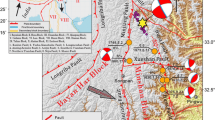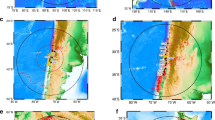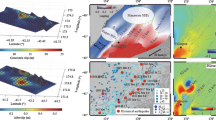Abstract
The Mw 7.8 Kaikōura, North Canterbury, New Zealand earthquake, which occurred on 14 November 2016 (local time), was one of the most complex continental earthquakes ever documented and among the largest instrumentally recorded events in New Zealand history. The epicenter was located at the southern termination of the Hikurangi margin, where the subducting Pacific Plate transfers into the dextral Alpine transform fault. In this work, we precisely estimate three-dimensional coseismic and postseismic displacements caused by this event from continuous global navigation satellite systems (GNSS) stations in New Zealand. The Kaikōura earthquake activated significant and diverse coseismic and postseismic deformation on a large spatial scale, located mainly in the southern part of the North Island and the northern part of the South Island. Station CMBL had the largest coseismic offsets and the most remarkable postseismic displacements. The accumulated postseismic displacements at this station reached 13, 7 and 29% of the coseismic values on the east, north and vertical components, respectively, in the first 1.5 years after the mainshock. Integrating our estimated coseismic displacements with previously published coseismic displacements, we inverted for the spatial distribution of coseismic slip and spatiotemporal evolution of postseismic slip. Our optimal coseismic model suggests that rupture occurred both on shallow crustal faults, and to some extent at the southern Hikurangi subduction interface. The GPS-inverted coseismic moment release is equivalent to an Mw 7.9 event. The postseismic slip was not only significantly extended at the subduction interface, but also appeared on the Needles fault. The cumulative moment magnitude is Mw 7.35 in the first 1.5 years after the event, and Mw 7.35, Mw 6.95 and Mw 6.80 during the periods 0.0–0.5, 0.5–1.0 and 1.0–1.5 years, respectively, indicating rapid decay of the postseismic deformation. Comparing the spatial distribution of the postseismic to the coseismic slip, although their direction is similar, the discrepancy between their location is significant: the slip located along the shallow crustal faults activated the coseismic deformation, while the slip located on the deep subduction interface controlled the postseismic deformation.













Similar content being viewed by others
References
Altamimi, Z., Rebischung, P., Metivier, L., & Collilieux, X. (2016). ITRF2014: A new release of the international terrestrial reference frame modeling nonlinear station motions. Journal of Geophysical Research,121, 6108–6131. https://doi.org/10.1002/2016JB013098.
Azua, B. M., Demets, C., & Masterlark, T. (2002). Strong interseismic coupling, fault afterslip, and viscoelastic flow before and after the Oct. 9, 1995 Colima-Jalisco earthquake: Continuous GPS measurements from Colima, Mexico. Geophysical Research Letters,29(8), 121–122.
Bai, Y., Lay, T., Cheung, K. F., & Ye, L. (2017). Two regions of seafloor deformation generated the tsunami for the 13 November 2016, Kaikōura, New Zealand earthquake. Geophysical Research Letters,44, 6597–6606. https://doi.org/10.1002/2017GL073717.
Barbot, S., & Fialko, Y. (2010). A unified continuum representation of post-seismic relaxation mechanisms: semi-analytic models of afterslip, poroelastic rebound and viscoelastic flow. Geophysical Research Letters,182(3), 1124–1140.
Beavan, J., Moore, M., Pearson, C., Henderson, M., Parsons, B., Bourne, S., et al. (1999). Crustal deformation during 1999–1998 due to oblique continental collision in the central Southern Alps, New Zealand, and implications for seismic potential of the Apline fault. Journal of Geophysical Research,104(B11), 25233–25255.
Beavan, J., Tregoning, P., Bevis, M., Kato, T., & Meertens, C. (2002). Motion and rigidity of the Pacific plate and implications for plate boundary deformation. Journal of Geophysical Research. https://doi.org/10.1029/2001jb000282.
Bedford, J., Moreno, M., & Li, S. (2016). Separating rapid relocking, afterslip, and viscoelastic relaxation: An application of the postseismic straightening method to the Maule 2010 cGPS. Journal of Geophysical Research,121(10), 7618–7638. https://doi.org/10.1002/2016JB013093.
Cesca, S., Zhang, Y., Mouslopoulou, V., Wang, R., Saul, J., & Savage, M. (2017). Complex rupture process of the Mw 7.8, 2016, Kaikōura earthquake, New Zealand, and its aftershock sequence. Earth and Planetary Science Letters,478, 110–120. https://doi.org/10.1016/j.epsl.2017.08.024.
Clark, K. J., Nissen, E. K., Howarth, J. D., Hamling, I. J., Mountjoy, J. J., & Ries, W. F. (2017). Highly variable coastal deformation in the 2016 Mw 7.8 Kaikōura earthquake reflects rupture complexity along a transpressional plate boundary. Earth and Planet Science Letters,474, 334.
Duputel, Z., & Rivera, L. (2017). Long-period analysis of the 2016 Kaikōura earthquake. Physics of the Earth and Planetary Interiors,265, 62–66. https://doi.org/10.1016/j.pepi.2017.02.004.
Ekstrom, G., Nettles, M., & Dziewonski, A. M. (2012). The global CMT project 2004–2010: centroid-moment tensors for 13,017 earthquakes. Physics of the Earth and Planetary Interiors,200–201, 1–9. https://doi.org/10.1016/j.pepi.2012.04.002.
Hamling, I. J., Hreinsdottior, S., Clark, K., Elliott, J., Liang, C., Fielding, E., Litchfield, N., Villamor, P., Wallace, L., Wright, T. J., D’Anastasio, EBannister, S., Burbidge. D., Denys, P., Gentle, P., Howarth, J., Mueller, C., Palmer, N., Pearson, C., Power, W., Barnes, P., Barrell, D.J.A. Dissen, R. V., Langridge, R., Little, T., Nicol, A., Pettinga, J., Rowland, J., & Stirling, M. (2017). Complex multifault rupture during the 2016 Mw 7.8 Kaikōura earthquake, New Zealand. Science, https://doi.org/10.1126/science.aam7194.
Herring, T. A., King, R. W., Floyd, M. A., & McClusky, S. C. (2015). GAMIT reference manual, version 10.60. Cambridge, MA: Massachusetts Institute of Technology.
Hollingsworth, J., Ye, L., & Avouac, J. P. (2017). Dynamically triggered slip on a splay fault in the Mw 7.8 2016 Kaikōura (New Zealand) earthquake. Geophysical Research Letters,44, 3517–3525. https://doi.org/10.1002/2016GL072228.
Huang, M. H., Bürgmann, R., & Freed, A. M. (2014). Probing the lithospheric rheology across the eastern margin of the Tibetan Plateau. Earth and Planetary Science Letters,396, 88–96. https://doi.org/10.1016/j.epsl.2014.04.003.
Jiang, Z. S., Yuan, L. G., Huang, D. F., Yang, Z. R., & Chen, W. F. (2017). Postseismic deformation associated with the 2008 Mw 7.9 Wenchuan earthquake, China: Constraining fault geometry and investigating a detailed spatial distribution of afterslip. Journal of Geodynamics,112, 12–21. https://doi.org/10.1016/j.jog.2017.09.001.
Jiang, Z. S., Yuan, L. G., Huang, J. F., Zhang, L. P., Hassan, A., & Yang, Z. R. (2018). Spatial–temporal evolution of slow slip movements triggered by the 2016 Mw 7.8 Kaikōura earthquake, New Zeland. Tectonophysics,744, 72–81. https://doi.org/10.1016/j.tecto.2018.06.012.
Kaiser, A., Balfour, N., Fry, B., Holden, C., Litchfield, N., & Gerstenberger, M. (2017). The 2016 Kaikōura, New Zealand, earthquake: Preliminary seismological report. Seismological Research Letters,88(3), 727–739. https://doi.org/10.1785/0220170018.
Lamb, S., & Smith, E. (2013). The nature of the plate interface and driving force of interseismic deformation in the New Zealand plate-boundary zone, revealed by the continuous GPS velocity field. Journal of Geophysical Research,118, 3160–3189. https://doi.org/10.1002/jgrb.50221.
Litchfield, N. J., Villamor, P., Van Dissen, R. J., Nicol, A., Barnes, P. M., Barrell, D. J. A., et al. (2018). Surface rupture of multiple crustal faults in the 2016 Mw 7.8 Kaikōura, New Zealand, earthquake. Bulletin of the Seismological Society of America.,108(33), 1496–1520. https://doi.org/10.1785/0120170300.
Nicol, A., Mazengarb, C., Chanier, F., Rait, G., Uruski, C., & Wallace, L. (2007). Tectonic evolution of the active Hikurangi subduction margin, New Zealand, since the Oligocene. Tectonics. https://doi.org/10.1029/2006tc002090.
Nikolaidis, R. (2002). Observation of geodetic and seismic deformation with the global positioning system. San Digeo: University of California.
Okada, Y. (1985). Surface deformation due to shear and tensile faults in a half space. Bulletin of the Seismological Society of America,75, 1135–1154.
Pillans, B. (1983). Upper Quaternary marine terrace chronology and deformation, South Taranaki, New Zealand. Geology,11(5), 292–297.
Reyners, M., & Bannister, S. (2007). Earthquakes triggered by slow slip at the plate interface in the Hikurangi subduction zone, New Zealand. Geophysical Research Letters. https://doi.org/10.1029/2007gl030511.
Scholz, C. H. (1990). The mechanics of earthquake faulting. Cambridge: Cambridge University Press.
Stirling, M. W., Litchfield, N., Villamor, P., Van Dissen, R., Nicol, A., Pettinga, J., et al. (2017). The Mw 7.8 2016 Kaikōura earthquake: surface fault rupture and seismic hazard context. Bulletin of the New Zealand National Society for Earthquake Engineering,50, 73–84.
Stirling, M., Mcverry, G., & Gerstenberger, M. (2012). National seismic hazard model for New Zealand: 2010 Update. Bulletin Seismological Society America,102(4), 1514–1542.
Suito, H., & Freymueller, J. T. (2009). A viscoelastic and afterslip postseismic deformation model for the 1964 Alaska earthquake. Journal of Geophysical Research. https://doi.org/10.1029/2008jb005954.
Sutherland, R., Davey, F., & Beavan, J. (2000). Plate boundary deformation in South Island, New Zealand, is related to inherited lithospheric structure. Earth and Planetary Science Letters,177(3–4), 141–151.
Tobita, M. (2016). Combined logarithmic and exponential function model for fitting postseismic GNSS time series after 2011 Tohoku-Oki earthquake. Earth Planets Space,68, 41. https://doi.org/10.1186/s40623-016-0422-4.
Van Dissen, R., & Nicol, A. (2009). Mid-late Holocene paleoseismicity of the eastern Clarence fault, Marlborough: New Zealand: New Zealand. Journal of Geophysical Research,52, 195–208. https://doi.org/10.1080/00288300909509886.
Walcott, R. I. (1984). The kinematics of the plate boundary zone through New Zealand: A comparison of short- and long-term deformations. Geophysical Research Letters,79(2), 613–633.
Wallace, L. M., & Beavan, J. (2010). Diverse slow slip behavior at the Hikurangi subduction margin, New Zealand. Journal of Geophysical Research,115, B12402. https://doi.org/10.1029/2010JB007717.
Wallace, L. M., Beavan, J., Mccaffrey, R., & Darby, D. (2004). Subduction zone coupling and tectonic block rotations in the North Island, New Zealand. Journal of Geophysical Research. https://doi.org/10.1029/2004jb003241.
Wallace, L. M., Hreinsdottir, S., Ellis, S., Hamling, I., D’Anastasio, E., & Denys, P. (2018). Triggered slow slip and afterslip on the southern Hikurangi subduction zone following the Kaikōura earthquake. Geophysical Research Letters. https://doi.org/10.1002/2018gl077385.
Wallace, L. M., Kaneko, Y., Hreinsdottir, S., Hamling, I., Peng, Z., Bartlow, N., et al. (2017). Large-scale dynamic triggering of shallow slow slip enhanced by overlying sedimentary wedge. Nature Geoscience,10, 765–770. https://doi.org/10.1038/ngeo3021.
Wallace, L. M., Reyners, M., Cochran, U., Bannister, S., Barnes, P. M., Berryman, K., et al. (2009). Characterizing the seismogenic zone of a major plate boundary subduction thrust: Hikurangi Margin, New Zealand. Geochemistry Geophysics Geosystems. https://doi.org/10.1029/2009gc002610.
Wang, L., Wang, R., Roth, F., Enescu, B., Hainzl, S., & Ergintav, S. (2009). Afterslip and viscoelastic relaxation following the 1999 M 7.4 Ízmit earthquake, from GPS measurements. Geophysical Research Letters,178, 1220–1237.
Wang, T., Wei, S., Shi, X., Qiu, Q., Li, L., & Peng, D. (2018). The 2016 Kaikōura earthquake: Simultaneous rupture of the subduction interface and overlying faults. Earth and Planetary Science Letters,482, 44–51. https://doi.org/10.1016/j.epsl.2017.10.056.
Wessel, P., & Smith, W. H. F. (1991). Free software helps map and display data. Eos Transactions American Geophysical Union,72, 441. https://doi.org/10.1029/90EO00319.
White, J. C., & White, S. H. (1983). Semi-brittle deformation within the Apline fault zone, New Zealand. Journal of Structural Geology,5(6), 579–589.
Xu, W., Feng, G., Meng, L., Zhang, A., Ampuero, J. P., Burgmann, T., et al. (2018). Transpressional rupture cascade of the 2016 Mw 7.8 Kaikōura earthquake, New Zealand. Journal of Geophysical Research: Solid Earth. https://doi.org/10.1002/2017JB015168.
Zhang, H., Koper, K. D., Pankow, K., & Ge, Z. (2017). Imaging the 2016 Mw 7.8 Kaikōura, New Zealand earthquake with teleseismic P waves: A cascading rupture across multiple faults. Geophysical Research Letters,44, 4790–4798.
Zus, F., Dick, G., Dousa, J., & Wickert, J. (2015). Systematic errors of mapping functions which are based on the VMF1 concept. GPS Solutions,19, 277–286.
Acknowledgements
The raw cGPS data were downloaded from New Zealand’s GeoNet and PositioNZ network. This work was financially supported by the National Natural Science Foundation of China (grant nos. 41604007 and 41874024), the Special Fund of China Experiment Site (grant no. 2018CSES0207), International Science & Technology Cooperation Program of China (grant no. 2015DFR21100) and the Basic Research Project of the Institute of Earthquake Forecasting, China Earthquake Administration (grant nos. 2016IES010203 and 2018IEF010102 and 2017IES0401). Some figures were prepared using the GMT graphics package (Wessel and Smith 1991).
Author information
Authors and Affiliations
Corresponding author
Additional information
Publisher's Note
Springer Nature remains neutral with regard to jurisdictional claims in published maps and institutional affiliations.
Rights and permissions
About this article
Cite this article
Su, X., Meng, G., Su, L. et al. Coseismic and Early Postseismic Deformation of the 2016 Mw 7.8 Kaikōura Earthquake, New Zealand, from Continuous GPS Observations. Pure Appl. Geophys. 177, 285–303 (2020). https://doi.org/10.1007/s00024-019-02169-5
Received:
Revised:
Accepted:
Published:
Issue Date:
DOI: https://doi.org/10.1007/s00024-019-02169-5




